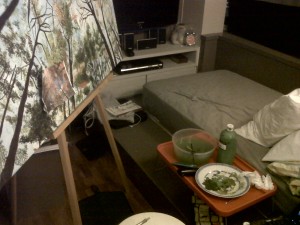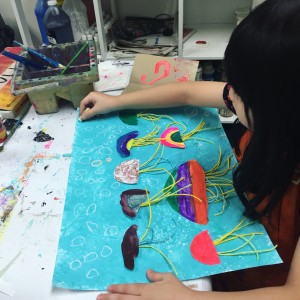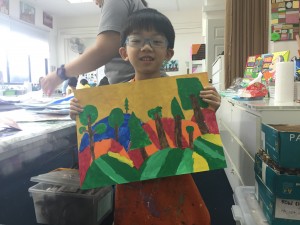Hi there. I’m Cherie, a final year undergraduate majoring in Psychology at Nanyang Technological University.
This blog is put up as part of a project for a Conservation Psychology module I’m taking. As the title of the website says, the role of Eco Art in Conservation is explored in this blog.
Why art in conservation?
Growing up, I took art classes as a kid and majored in it during secondary school and junior college. I now teach art to children as a part-time job. Art has pretty much been a part of my life. And nature appears in Art, a lot:
A painting I did for school 5 years back.
As a part-time art teacher to children aged between 3-8, a lot of artworks we do revolve around the theme of nature.
So…I live in a concrete jungle/ city of Singapore- how is my environmental identity even created?!
Despite growing up here, my relationship with nature have been fostered with a few experiences.
Trekking/outdoor trips:
Volcano in Indonesia, Padang, Kerinci Seblat National Park Mt. Kerinci.
3,805m above sea level
This trekking trip was a killer. The trek was way extremely demanding and way tougher than what I expected. It wouldn’t stop raining at that time, making the conditions of climb extremely slippery, muddy and cold. It was this trip that fostered a strong identity in nature as my psychological needs such as autonomy and competence were tested and met in the difficult conditions of the hike. It also made me appreciate both my body and nature as a system.

Thailand, Chiang Mai, Doi Inathon National Park
Doi Inathon National Park was beautiful. Waterfalls and romantic views of a pristine nature? Affective component. Check. I tend to be overly amazed, appreciative and then humbled by the beauty of nature.




Dolomites in Northeast of Italy at a village Madonna Di Campiglio.
I spent summer here living amongst the dolomites and went mountain biking, and rock climbing. I had a donkey as my neighbour too. It was a very new and different lifestyle from what I’m used to. As it is a small village with about 1,000 population, trash disposal system was extremely responsible and “strict”. There were hardly any food waste, all recyclables were washed clean and collected, and there was only one point of trash collection that was a 10-15 minutes drive away.







In the ocean:
Free Diving Course in Philippines, Boracay
Free-diving is a form of diving that depends on one’s ability to hold their breath underwater instead of using oxygen tanks or other apparatuses. This was a transcendent experience that made me question about a viable perspective to think about our influence on the environment is to base it to being as close as possible to existing natural systems. After being underwater for an extended period of time, it irked me as I thought more about the detrimental effects pollution have on the marine life.


Snorkeling at Maldives
I stayed at a local island in Maldives. As Maldives is made up of thousands of tiny islands, the one I lived on only had less than 500 inhabitants and it took me approximately 25 mins to walk from one end to the other end of the island. I noticed the strong community ties the locals had, and their extremely cooperative systems in place when it came to transporting goods into the island. Every item was passed on single handedly by men, where they formed a line from the boat, to the deck, to the harbor, and to land. The community did not seem to be materialistic focused.


Mixing these personal experiences with nature, knowledge learnt in conservation psychology class over the semester, and my little art background, this blogs present the role of artists in conservation! Enjoy!








